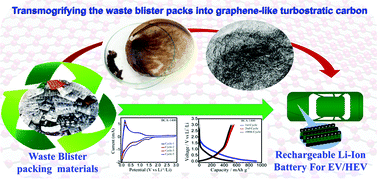Transmogrifying waste blister packs into defect-engineered graphene-like turbostratic carbon: novel lithium-ion (Li-ion) battery anode with noteworthy electrochemical characteristics†
Abstract
Blister packing materials (BMs) made up of foamed plastics are one of the major components in consumer goods, pharmaceuticals, and medical devices, which lead to a serious environmental concern as the waste management processes often result in land filling and incineration. The effective recycling of these foamed plastics has turned out to be a topic of interest in recent years to address environmental issues. Under stipulated experimental conditions, the foamed plastic of blister packaging materials, consisting of a higher percentage of carbon can provide an efficient anode material for energy storage devices. The present work outlines the preparation steps of defect-engineered graphene-like turbostratic carbon via. a physico-chemical activation method resulting in the formation of ultralow surface area (∼11.4 m2 g−1) carbon materials. In addition, graphene-like wrinkled morphologies were found to exist in the carbonaceous materials prepared at higher activation temperature (∼1400 °C) with a notable change in the crystalline characteristics on par with the commercial graphite anode. Therefore, it is expected that the material could be used in the same manner as conventional graphite materials to fabricate the cells. The prepared carbon, when explored as a lithium-ion battery (Li-ion) anode, provided outstanding electrochemical properties with a noteworthy Li-ion storage capacity of 594 mA h g−1 measured at a current rate of 0.1 C after 200 cycles, thanks to its graphene-like features, facilitating faster Li+ diffusion. Even at a high C-rate (1 C), the waste plastic-derived carbon displayed outstanding rate performance (∼304 mA h g−1) with noteworthy capacity retention (∼89%) and enhanced cycling stability (over 2000 cycles). Thus, the present research paves a new route for generating value-added carbon materials using foamed plastic med-wastes derived from blister packs.



 Please wait while we load your content...
Please wait while we load your content...